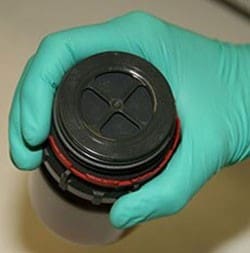AcroSeal Packaging

The AcroSeal system: performance, convenience, safety
Chemical reactions often involve the use of air- and moisture-sensitive solvents, pyrophoric and hazardous reagents. Our AcroSeal™ packaging is an industry-leading packaging solution for safer handling of these types of materials, which are used in drug discovery, agrochemical research, flavors and fragrances, diagnostics, NMR analysis and other applications.
If you are new to AcroSeal Packaging, please see "How to use AcroSeal packaging" below.

The new AcroSeal cap
What's changing?
We have recently improved our AcroSeal packaging. The redesigned gray portion of the sealing system makes it both easier and safer to remove the whole system and replace it back on the bottle securely. No special tool is required for removal or replacement. This facilitates access to larger volumes of product and packaging recycling after use.
Frequently asked questions about our updated AcroSeal packaging
How has it been made more difficult to accidentally remove the whole system from the bottle?
Read more
How to use AcroSeal packaging

To get the best results using AcroSeal packaging, we recommend the following process:
1. Puncture the septum
2. Withdraw the required amount
3. Replace the nitrogen blanket
4. Store upright to prevent prolonged product contact with the seal
Advanced tips:
- Prepare the nitrogen balloon in advance and use two balloons, one inside the other
- Purge the doubled balloons with nitrogen three times before use
- Bend the needle as it makes it easier to use and control
- Flush each needle and syringe with nitrogen three times before use
- Use the reaction flask to flush the syringe and needle prior to use
To get the best results from the septum, we recommend you use 18 to 21 gauge needles and puncture in a clock face pattern to avoid piercing the septum in the same place.
If you require a large amount of solvent, remove the whole cap under an inert atmosphere and decant the desired amount of product from the bottle.
AcroSeal packaging applications
Grignard reagents
Our AcroSeal-packaged Grignard reagents ensure the exclusion of air and moisture from Grignard reaction conditions for carbon-carbon bond formation.
Alkyllithium reagents
We offer a wide selection of AcroSeal-packaged organolithium compounds for reactions such as transmetallation and nucleophilic addition and substitution.
Metal hydrides
Our AcroSeal-packaged hydrides, extremely pyrophoric reducing agents, can be used safely in the reduction of esters, carboxylic acids and amides.
Dry Solvents
When using air- and moisture-sensitive solvents and reagents, it is essential that these products are not only as dry as possible when you first use them, but they should remain dry in storage as well.
